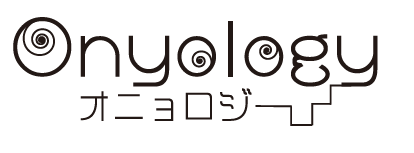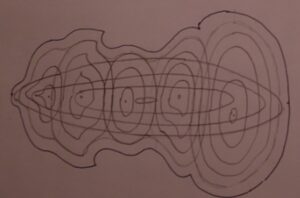Shape and sound of ancient musical instruments -part1
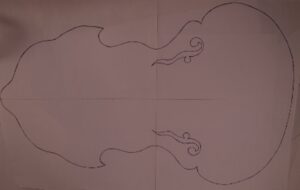
I aligned the sounds of the outer frame and carved it.
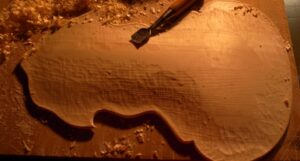
The shape of this instrument is characterized by a vertically long stack of multiple drums (resonance plates) and an inwardly piercing depression at the bottom of the outline. In order to increase the resonance, we carve the resonance plate so that the sound to be scraped has the same pitch, but where should we start scraping on the resonance plate?
One method is to carve toward the center while increasing the resonance of the peripheral part of the resonance plate. The other method is to make small drums (partial resonance) on the resonance plate and finally integrate them into a large drum.

In fact, as I carved it, I came to the conclusion that it was impossible to integrate this shape into an isophonic surface. As I carved, the partial resonance expanded, the shape became thinner and thinner. If I match the sound in one part, it doesn’t match in another part, and if I carve to that part, another part will be ……, and so on, and the sound group will not close forever.
I wonder why?
The answer was in the shape of the instrument’s outline. The motivation for making this ghostly pumpkin-like instrument was that I thought the way to make an instrument with the phonogram did not depend on the shape of the outline. I was looking for possibilities for more freely shaped instruments, not just violins.
However, in this experiment, it was found that the outline must be constrained in order to actually construct an isophonic surface.
Next, I decided to make an instrument with a different shape.
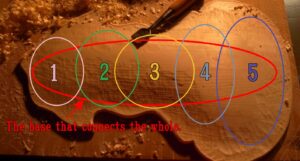
This instrument can be interpreted as an instrument in which several drums (resonance plates) of different sizes are overlapped as shown in the figure above. Each has a different size and shape. Of course, each acoustic characteristic is also different. Can each of these resonators coexist as a unified body?
In order to coexist, a base is needed to hold the small resonators together. The base part is the bold line in the figure. This shape inevitably results in an elongated shape. If I manage to unify it, I have to base it on this elongated piece.
When I actually carved it, it became like the figure below.
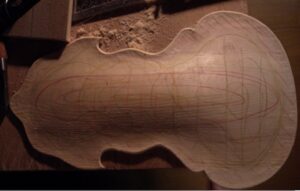
It has a slightly unpleasant shape. We connect each small part to this bass part in a consonant relationship, but the shape is inevitably thin. After all, we are making an instrument like the one shown below.

It is an instrument that consists of a resonator with several smaller partial resonators attached to it linearly, in other words, an elongated instrument. For example, the Turkish folk instrument Kemenche is one such instrument. “Ghostly Pumpkin” can be seen as a deformation of the Kemenche.
It is presumed that the acoustic characteristics of an elongated musical instrument have many components in the bass part (bass) and the treble part (small drum group in the middle), and there is no vibration in the intermediate region connecting them. Incidentally, a famous violin instrument exhibits acoustic characteristics that include the full range of vibrations in the bass, middle, and treble domains (White noise). This “Ghostly Pumpkin” can’t at least make a violin-like clear sound.
To be continued…
- カテゴリー
- BLOG
